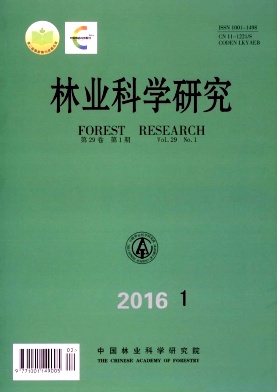|
[1]
|
旷远文,温达志,周国逸,等. 大气污染胁迫下9种植物幼苗叶片热值、C/N和灰分含量比较[J]. 热带亚热带植物学报,2005,13(2): 117-122.
|
|
[2]
|
Golley F B. Caloric value of wet tropical forest vegetation[J]. Ecology,1969,50(3): 517-519. |
|
[3]
|
Bliss L. Caloric and lipid content in alpine tundra plants[J]. Ecology,1962,43(4): 753-757. |
|
[4]
|
卜文圣,臧润国,丁 易,等. 海南岛热带低地雨林群落水平植物功能性状与环境因子相关性随演替阶段的变化[J]. 生物多样性,2013,21(3): 278-287.
|
|
[5]
|
杨冬梅,章佳佳,周 丹,等. 木本植物茎叶功能性状及其关系随环境变化的研究进展[J]. 生态学杂志,2012,31(3): 702-713.
|
|
[6]
|
孟婷婷,倪 健,王国宏. 植物功能性状与环境和生态系统功能[J]. 植物生态学报,2007,31(1): 150-165.
|
|
[7]
|
Long F L. Application of calorimetric methods to ecological research[J]. Plant Physiology,1934,9(2): 323. |
|
[8]
|
Singh T,Kostecky M M. Calorific value variations in components of 10 Canadian tree species[J]. Canadian Journal of Forest,1986,16(6): 1378-1381. |
|
[9]
|
Gorham E,Sanger J. Caloric values of organic matter in woodland,swamp,and lake soils[J]. Ecology,1967,48(3): 492-494. |
|
[10]
|
谭 勇,李晓景,何东进,等. 中国红树林天然分布北缘区不同起源秋茄热值特征研究[J]. 北京林业大学学报,2013,35(6): 55-60.
|
|
[11]
|
林益明,林 鹏,王 通. 几种红树植物木材热值和灰分含量的研究[J]. 应用生态学报,2000,11(2): 181-184.
|
|
[12]
|
任 海,彭少麟,刘鸿先,等. 鼎湖山植物群落及其主要植物的热值研究[J]. 植物生态学报,1999,23(2): 53-59.
|
|
[13]
|
徐永荣,张万均,冯宗炜,等. 天津滨海盐渍土上几种植物的热值和元素含量及其相关性[J]. 生态学报,2003,23(3): 450-455.
|
|
[14]
|
林 鹏,邵 成,郑文教. 福建和溪亚热带雨林优势植物叶的热值研究[J]. 植物生态学报,1996,20(4): 303-309.
|
|
[15]
|
李 宏,程 平,郑朝晖,等. 克拉玛依地区主要树种干部热值与碳含量特征分析[J]. 林业科学,2013,49(9): 29-37.
|
|
[16]
|
杨国平,巩合德,郑 征,等. 哀牢山常绿阔叶林优势树种热值与养分特征[J]. 浙江林学院学报,2010,27(2): 251-258.
|
|
[17]
|
Telmo C,Lousada J,Moreira N. Proximate analysis, backwards stepwise regression between gross calorific value, ultimate and chemical analysis of wood[J]. Bioresource Technology,2010,101(11): 3808-3815. |
|
[18]
|
高扬子,何洪林,张 黎,等. 近50年中国地表净辐射的时空变化特征分析[J]. 地球信息科学学报,2013,15(1): 1-10.
|
|
[19]
|
孟 猛,倪 健,张治国. 地理生态学的干燥度指数及其应用评述[J]. 植物生态学报,2004,28(6): 853-861.
|
|
[20]
|
王立海,孙墨珑. 小兴安岭主要树种热值与碳含量[J]. 生态学报,2009,29(2): 953-959.
|
|
[21]
|
田 苗,宋广艳,何念鹏,等. 亚热带常绿阔叶林和暖温带落叶阔叶林叶片热值比较研究[J]. 生态学报,2015,35(23):1-9.
|
|
[22]
|
高 凯,宋 赋,朱铁霞. 基于大尺度条件探讨若干因素对植物热值的影响[J]. 草业科学,2012,29(3): 453-458.
|
|
[23]
|
张 伟,蔡会德,农胜奇. 广西主要树种热值研究[J]. 中南林业调查规划,2011,30(1): 50-53.
|
|
[24]
|
Wielgolaski F E,Kjelvik S. Energy content and use of solar radiation of Fennoscandian tundra plants[M]. Wielgolaski F.E. Fennoscandian tundra ecosystems. Part 1: Plants and microorganisms,Berlin:Springer-Verlag,1975,201-207. |
|
[25]
|
林 鹏,林光辉. 几种红树植物的热值和灰分含量研究[J]. 植物生态学与地植物学学报,1991,15(2): 114-120.
|
|
[26]
|
官丽莉,周小勇,罗 艳. 我国植物热值研究综述[J]. 生态学杂志,2005,24(4): 452-457.
|
|
[27]
|
林 华,曹 敏,张建侯. 中国西南地区热带季节雨林及山地常绿阔叶林热值及能量分配格局(英文)[J]. 植物生态学报,2007,31(6): 1103-1110.
|
|
[28]
|
李意德,吴仲民,曾庆波,等. 尖峰岭热带山地雨林主要种类能量背景值测定分析[J]. 植物生态学报,1996,20(1): 1-10.
|
|
[29]
|
鲍雅静,李政海,韩兴国,等. 植物热值及其生物生态学属性[J]. 生态学杂志,2006,25(9): 1095-1103.
|
|
[30]
|
江丽媛,彭祚登,何宝华,等. 5个年龄栓皮栎热值与灰分含量的分析[J]. 南京林业大学学报:自然科学版,2011,35(5): 40-44.
|
|
[31]
|
James T,Smith D. Seasonal changes in the caloric value of the leaves and twigs of Populus tremuloides[J]. Canadian Journal of Botany,1978,56(15): 1804-1805. |
|
[32]
|
高 凯,朱铁霞. 三种城市绿化树种针叶热值和灰分含量动态变化研究[J]. 北方园艺,2014(21): 83-86.
|
|
[33]
|
牛 聪,杨伟波,唐龙祥. 4个主栽椰子品种叶片热值季节性变化研究[J]. 热带农业科学,2012,32(6): 11-14.
|
|
[34]
|
黄建容. 湿地松针叶热值的季节动态研究[J]. 现代农业科技,2010(17): 204-205.
|
|
[35]
|
于应文,胡自治,张德罡. 天祝金强河高寒地区金露梅的热值及其季节动态[J]. 草业科学,2000,17(2): 1-4.
|
|
[36]
|
杨盛昌,李云波,林 鹏. 冷胁迫下红树植物白骨壤和桐花树叶片热值的变化[J]. 台湾海峡,2003,22(1): 46-52.
|
|
[37]
|
杨京平,Wekesa BONIFACe,姜 宁,等. 不同氮素水平下气象因子对两种水稻热值影响的分析[J]. 中国水稻科学,2001,15(3): 74-77.
|
|
[38]
|
朱军涛,李向义,张希明,等. 昆仑山北坡前山带塔里木沙拐枣对不同海拔生境的生理生态响应[J]. 生态学报,2010,30(3): 602-609.
|





 DownLoad:
DownLoad: